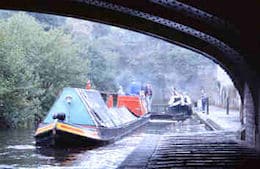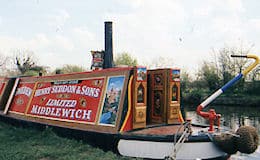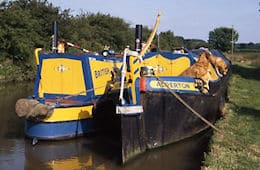Canal narrowboats
The first and most fundamental subdivision to make is between narrow boats and the rest, between those canal boats built about seven foot wide, small enough to travel through the interconnecting Midland waterways, and all the other myriad boats and barges of the river systems that the eighteenth century canals linked together.
Because those early artificial waterways were such huge undertakings for their time, both in cost and labour, they were only built as big as was thought to be practical and economic.
The size of the canal boat was constrained by the depth of the water and the dimension of the locks through which it had to pass. An inch too big and it couldn’t go anywhere and couldn’t earn its living. Too small and it couldn’t carry enough tonnage to pay its way either, so size was critical.
Someone – and evidence suggests that it was the famous canal engineer James Brindley – decided that the earliest canals to span the country and link up the rivers should be built just big enough to pass long thin canal boats, ten times as long as they were wide, drawing about three feet of water when loaded. This is tiny today in barge terms, but it was a huge advance in the eighteenth century and as they remained competitive until the middle of the twentieth it would seem to have been a pretty farsighted decision.
For the first century and a half of the canal age narrow boats were generally made of wood and pulled by horses. Iron and steel boats were gradually introduced during the nineteenth century but wooden ones traditionally built with oak and elm were still being launched into the 1950s and a fair number are still afloat today. In many cases they survive like ‘George Washington’s Axe’ – having had two new heads and five new handles – but they are still an important part of the continuity of canal culture, still demanding traditional skills to maintain them. Actual horse-drawn boats are very rare except as day trip boats in specific areas but a few survive with their massive vividly painted wooden rudders and curved tillers bedecked with fancy white ropework.
Narrow boats with engines are quite recent relatively speaking. A number of steam driven boats were built in the late nineteenth century, but it was only when a reliable diesel engine became readily available in the 1920s that the proper motor canal boat came into its own. By the 1940s engines had replaced horses nearly everywhere although a few animals were still working in the 1960s.
The extra advantage that the new motor boat possessed was the power not only to push itself along, but to tow another dumb boat behind it as well. The same two-person crew that was needed to work one horse boat could now operate two boats and carry twice the tonnage and in theory double their wages too.
It was not quite that simple but this system of working narrow boats in pairs, each motor boat with its ‘butty’ behind it, undoubtedly helped the canals remain competitive against road and rail transport until the middle of the twentieth century. So confident were some of the canal authorities in the future of this system that the Grand Union Canal Company commissioned a new fleet of over 300 modern canal boats in the 1930s, designed to work as pairs on the London, Leicester and Birmingham routes. These bluff bowed Grand Union boats mainly built at Woolwich, Northwich and Rickmansworth, nearly all survive and are to be spotted all over the waterway system. Most are now converted to pleasure craft, but a few still work for a living and a significant number of the surviving unmotorised butties date from that bold expansion plan.
All materials and images © Canal Junction Ltd. Dalton House, 35 Chester St, Wrexham LL13 8AH. No unauthorised reproduction.
About | Terms | Privacy| Refunds & Returns| Sitemap | Contact Us
With over 800 pages, this website uses cookies to record visitor behaviour using Google Analytics. More information on Privacy Page. Page last updated: 31/03/2025.




Back to Menu....
Narrowboats & Barges >>
Canal Heritage >>